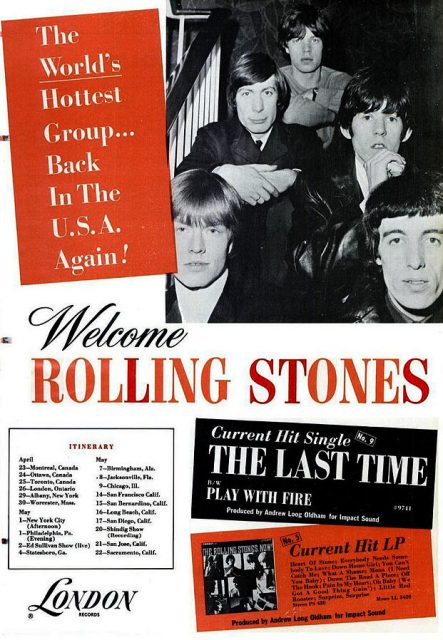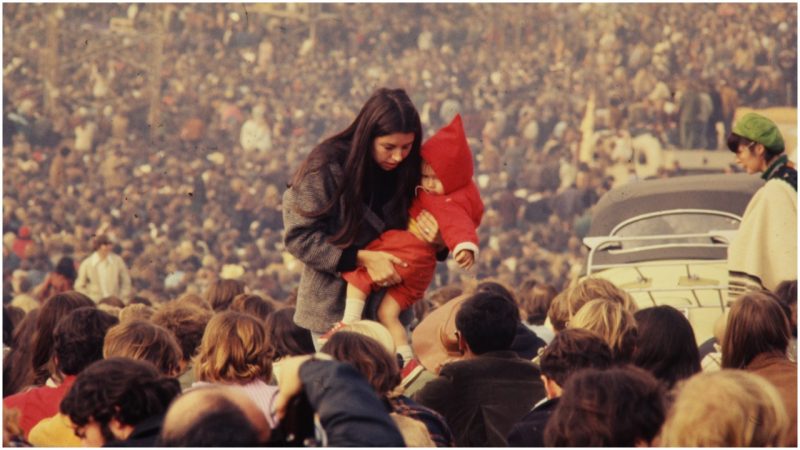In December 1969, the Rolling Stones had a vision of repeating the Woodstock experience with a free concert on the West Coast. The Altamont rock concert took place at the Altamont Speedway in northern California. It featured popular names such as Jefferson Airplane, Crosby, Stills, Nash & Young, Santana, and the Flying Burrito Brothers, and was headlined by the Rolling Stones. The free concert was meant to be the grand finale of the British band’s year-long tour across the United States.
Although the Stones expected to repeat the fame and glory of Woodstock in upstate New York, which they’d missed, the Altamont concert ended in chaotic violence, culminating with the death of student Meredith Hunter, who was killed by a Hells Angel biker, Alan Passaro.
But things had not gone well in the days leading up to December 6, 1969. First of all, the concert was meant to take place at Sears Point in Sonoma, near San Francisco, an area where many attendees could find decent accommodation. However, two days before the concert, landowners at Sears Point became greedy and asked for a fee of at least $100,000 as well as distribution rights to any film made at the concert. It probably could have been negotiated, but reportedly Jagger balked. Hence, in desperation, Altamont Speedway was chosen as the new location for the concert only two days ahead. A remote place, surrounded by garbage, tires, and wrecked cars, it lacked toilets or water, but the owner offered it for free.

The second ominous development was a group of Hells Angels were hired as security for $500 ($3,345 in 2017 currency) and free beer. It’s still unclear who exactly hired them. If someone had thought it through, you couldn’t expect a biker gang to have a lot of tolerance for a crowd high on joints and LSD trying to get close to the stage, which was only four feet high. Such a low stage at a free rock concert was obviously a bad idea, but there was no time to build a new one. Technically, everything was rushed and done at the last minute–the podium, the lighting, the sound system.
In her biography, Grace Slick said of Altamont: “The vibes were bad. Something was very peculiar, not particularly bad, just real peculiar. It was that kind of hazy, abrasive and unsure day. I had expected the loving vibes of Woodstock, but that wasn’t coming at me. This was a whole different thing.”
The atmosphere in front of the stage was hostile throughout the entire concert. In-person accounts report that, while everyone was trying to enjoy the music, the security guards soon started beating concertgoers, hurling full cans of beer into the audience, and using weighted motorcycle chains and pool cues to push the crowd away from the stage. What triggered this situation is unclear. During the first set by Santana, the Angels seriously hurt the Grateful Dead’s permit specialist, a non-violent peace activist named Bert Kanegson, who received 60 stitches in his head and had to wear a bandage that looked like a turban.
Denise Jewkes from the Ace of Cups was also attending the concert in her sixth month of pregnancy and got hit by a beer bottle, causing a skull fracture that required emergency surgery. Martin Balin of Jefferson Airplane was knocked down by a Hell’s Angel on stage, in front of the audience, while the band was performing. He continued beating Balin backstage and even knocked Rex Jackson of the Grateful Dead unconscious, for trying to rescue Balin.
It all culminated during the performance of the Rolling Stones. Although accounts differ, what is certain is that a student, Meredith Hunter, got into a scuffle with two of the Hells Angels and ended up being killed by one. By everyone’s accounts, including his girlfriend’s, Hunter was very high on drugs when he approached the scene. He got into a fight with the security guards and was brutally kicked. By this time, Jagger interrupted his band’s performance, appealing the audience to calm.
However, even if the audience was calm, the Angels were now primed for more trouble. Hunter approached the stage area once more, only this time he pulled a revolver from his jacket, most likely a long-barreled .22 caliber, which he pointed to the air. Most of what is known about that December evening comes from Gimme Shelter, a documentary by filmmakers Albert and David Maysles, which was filmed at the Altamont concert. The footage shows an orange flash at the end of Hunter’s pistol, but whether it is a film defect or it was a gunshot is hard to determine. But the following can be seen: Alan Passaro ran at Hunter with a knife, grabbed the boy’s pistol, and stabbed him.
But even Hunter’s death didn’t end the violence. It continued. Some say the murder of Hunter stands as a symbol of the beginning of the end of a careless hippie time. It is remembered as one of the darkest events in the history of rock: “The death of innocence,” Altamont was called.
Passaro was arrested, but acquitted on the grounds of self-defense. And, as for the Stones, well, they seemed alternately saddened, confused, and defensive.
In the documentary Gimme Shelter directed by David and Albert Maysles, drummer Charlie Watts, after remembering that the way the Hells Angels cleared a path before the concert “was incredible,” said quietly, “What a shame.”
Jagger said more. “Well, awful. I mean, just awful. You feel a responsibility. How could it all have been so silly and wrong? But I didn’t think of these things that you guys thought of, you in the press: this great loss of innocence, this cathartic end of the era … I didn’t think of any of that. That particular burden didn’t weigh on my mind. It was more how awful it was to have had this experience and how awful it was for someone to get killed.” This was Jagger’s response in “Jagger Remembers: The Rolling Stone Interview,” conducted by Rolling Stone publisher Jann Wenner.
In another story in published in Rolling Stone magazine, Keith Richards did not put the blame for the night on the band or the concert organizers but commented about cultural relativism, saying: “Really, the difference between the open air show we held in Hyde Park and the one there is amazing. I think it illustrates the difference between the two countries. In Hyde Park, everybody had a good time, and there was no trouble. You can put half a million young English people together, and they won’t start killing each other. That’s the difference.”
